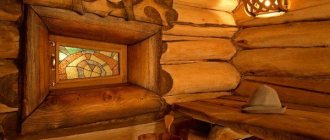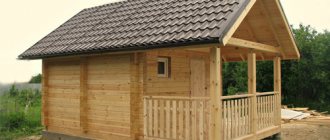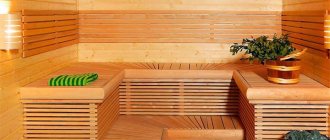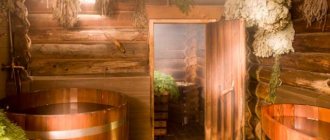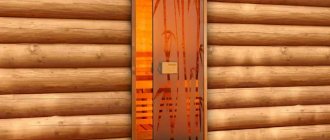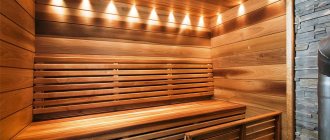The lining got its name thanks to trains. When the first carriages appeared, they were lined with thin boards, their thickness no more than two centimeters. It is the bath lining that is used for interior decoration; its service life is quite long: from 15 to 20 years.
In order to build a good bathhouse, you need to take into account not only the design.
It is recommended to cover the steam room and washing room exclusively with natural materials. It is extremely undesirable to use the practice of the USSR times and use ceramics or plastic materials for this purpose.
One has only to imagine what an incredible amount of unfavorable substances can be released from such materials under the influence of high temperatures. For this reason, the best option is to cover the walls in the bathhouse with natural wooden paneling.
There are several types of lining for a bath. For this reason, you need to pay great attention to the choice of material that is ideal for interior cladding, namely for the walls and ceilings of the bathhouse.
For finishing work in the bathhouse, the best materials are those made from natural wood. Therefore, it is advisable to pay attention to such materials as: lining made of larch, pine, spruce, linden, as well as aspen. These materials are very convenient for installation, easy to process, and also have an aesthetic appearance. Therefore, these products are in high demand among consumers.
All types of lining, according to their grade, are divided into 4 classes: “Extra”, A, B, C. The first type, namely the “Extra” class, is the highest quality, with a perfectly processed smooth surface without visible damage or flaws. Materials classified as category “A” must not have any defects or obvious manufacturing or natural defects on their surface.
However, class “B” and “C” linings are considered more affordable. And they have minor flaws on the surface, almost invisible to the naked eye.
Main features of the lining
The lining got its name due to the fact that it was first used exclusively for lining the inside of carriages. Its main distinguishing feature from conventional edged boards is the grooves. They are on the long sides of the panels. Thanks to the presence of grooves, the linings are tightly connected to each other. This allows you to beautifully sheathe surfaces. There will be no gaps or cracks on them.
Manufacturers produce several types of lining. Material options differ in the wood used, quality and size.
On a note! Manufacturers produce not only wooden, but also plastic lining. This material can also be used in a bathhouse, but for finishing only the locker room and dressing room. Plastic lining is not used for steam rooms because it is not resistant to high temperatures. At the same time, lumber is able to absorb and evaporate moisture. Thanks to this feature, it regulates the humidity in the room. In addition, properly selected wood has a positive effect on the human respiratory system, as it releases aromatic substances.
Wooden lining Source kalinales.kz
Reviews
Unfortunately, we were unable to find real reviews about pine baths, only individual remarks from participants in various forums, among whom were both supporters and opponents of the use of pine in the bath, and, as always, they were talking about the steam room.
There are people who say that they have never had problems with resin at all , but how can such luck be explained? Perhaps they confused pine with spruce - the latter actually cries less. Perhaps they have a Russian bathhouse and the temperature does not rise above 60 degrees. In addition, we must take into account that all the characteristics of trees are averaged, there is a scatter, and here it depends on your luck.
Choosing a lining for cladding the inside of a bathhouse
Regular and European standard linings are available. The first version of the material has a fleecy and rough surface. Eurolining is smooth wooden panels. On their back side there are recesses for ventilation. Thanks to the presence of such channels, moisture does not accumulate. The grooves also reduce stress in the lumber.
The permissible moisture level for wood products according to GOST 8242-88 is 12%. At the same time, conventional lining is often made from wood with a moisture content of 25%. For this reason, such panels often become deformed after installation during operation of the bath. Experts know this and therefore use wooden eurolining for finishing the steam room and other premises.
Wooden eurolining Source azbykalesa.ru
Wood for lining
When choosing lumber for the interior decoration of a bathhouse, the wood used during its manufacture is taken into account. Today you can line the inside of a bathhouse with clapboard, which is made from coniferous and hardwood. The material is selected depending on the properties of the wood and the purpose of the specific room in the building.
Linden lining
Linden has light wood with a brown and sometimes red tint. The material made from it has a matte shine and practically does not heat up. Low heat capacity eliminates the occurrence of burns if a person comes into contact with the surface of linden lamellas.
The material is characterized by low thermal conductivity, which allows it to distribute heat throughout the room. Thanks to this property, the walls cool down more slowly. Therefore, linden lumber is often used for cladding steam rooms. In addition, it is able to release aromatic components that have a positive effect on health. They calm and relax a person. The breed is also highly durable and practically does not dry out. The structure of linden consists of homogeneous fibers.
Linden lining Source cstor.nn2.ru
Lining made of Siberian or Canadian cedar
The lamellas of lumber from such species have a pinkish-brown color. Siberian or Canadian cedar is an expensive wood used in the finishing of luxury buildings. It has a positive effect on health, as it releases essential oils during the operation of the building. They improve the functioning of the respiratory system.
The wood of Siberian and Canadian cedar is not subject to rotting, allows for beautiful finishing, and is able to withstand mechanical loads perfectly. No cracks appear on it during the operation of the bath structure.
Canadian cedar lining Source allegroimg.com
Aspen lining
Another popular material for finishing bathrooms. It is distinguished by its white color. On the surface of the lumber you can even notice a silvery tint and barely visible yellowish growth rings. Aspen lining for bathhouses is popular because it is resistant to a humid environment, can withstand high temperatures and does not heat up, which eliminates the possibility of burns on the body.
The strength of lamellas made from this wood increases over time. This characteristic increases to the point where it becomes difficult to drive nails into the material. At the same time, it is easy to work with aspen slats because they initially have a soft structure. In addition, surfaces made from such lining do not require special care. If they darken during the use of the premises, it is enough to sand them a little to restore their former attractive appearance.
Aspen lining Source roomester.ru
See also: Catalog of companies that specialize in finishing materials and related work
Alder paneling
This lumber also cannot boast of a low price. It has a smooth surface. This allows you not to use a grinding machine for additional processing of the finished cladding. Alder slats contain tannins. The wood itself has a hygroscopic structure and is characterized by low thermal conductivity.
Oak lining
Finishing oak lumber is heavy, durable slats with a beautiful texture. They are difficult to process and have a high price. At the same time, oak lining does not rot and does not lose its properties during the operation of bathhouses. In addition, it does not require additional processing, which reduces finishing time.
Pine lining
Pine slats can be beige in color. Red-brown lumber is also available. As the premises are used, the pine panels begin to darken. The material is also distinguished by a clear pattern of growth rings. Resin channels are still visible on its surface.
Pine lining Source pilomaterial-stroi.ru
Pine lining has good viscosity. It is easy to process and has decent mechanical properties. However, after heating, resin appears on its surface. For this reason, pine slats are not used in the steam room, where human contact with the finished surfaces is possible. They are also not used for cladding the ceiling of a steam room, because after cladding it is necessary to repeatedly heat the room, and each time to remove the resin that appears. Such processes must be repeated until its appearance on the finished surfaces stops.
On a note! In the bathhouse, panels made of pine and other coniferous species are used in the dressing room and the washroom. They are cheaper than lining made from aspen for baths and other hardwoods. At the same time, pine panels are resistant to a humid environment, which is often increased by applying a water-repellent agent, for example, protective wax. Coniferous lumber is distinguished by a variety of shades, simple processing, and attractive texture. It gives off a pleasant aroma, which is why it is often chosen for decoration.
Pine lining in the washing compartment Source vsaunu777.ru
Cladding classes
Manufacturers produce lining of different classes, which include materials with a certain density and having a specific quality of the outer surface. If there are a lot of knots in the panels, they will quickly heat up and burn a person on contact. Manufacturers produce lining of the following classes:
- Extra – there are no knots or cracks in the material. Professional lining of the steam room with “Extra” clapboard allows you to get a flat and smooth surface.
- A – the lamellas have a smooth surface. In this case, slight roughness is allowed. The panel may have one knot per 1 running meter, but its diameter should not exceed 15 mm. Hairline cracks are also acceptable. Their length should not exceed half the lining. The panels may also have non-through cracks, the length of which is not more than 95 mm. The presence of crack-like defects that appeared during drying is also allowed. Their length should not exceed the width of the lamella. In addition, there may be resin pockets. Their permissible maximum quantity is 2 pieces per linear meter.
Class A lining panels Source garant-karelia.ru
Brooms
Bath brooms are made from a wide variety of branches and herbs, each for a specific purpose .
A pine bath broom releases a lot of essential oils when steaming, so its aroma is very strong. By inhaling it, you simultaneously disinfect the respiratory tract , which will be a good prevention of colds. The smell of pine needles also has a tonic effect on the entire body - after the procedures you feel a great surge of strength and vigor.
While hovering with such a broom, the body receives its benefits - this is a massage, a tingling sensation that causes a rush of blood to the skin, and the transfer of beneficial substances that the pine needles contain to the skin.
According to the rules, the broom is prepared right before the procedure from straight, young branches. It is advisable to wrap the handle or use gloves, because resin will be released.
The broom is not steamed, but is poured with boiling water for a quarter of an hour . Afterwards, you can wrap it in cloth and put it on the top shelf for another five minutes. Under the influence of boiling water, the needles will become softer, their touch will become more pleasant.
ATTENTION! This broom can only be used once. Its usefulness is one-time only.
If resin gets on your skin during the procedures, you don’t need to do anything - then wipe it off with alcohol.
Interior decoration of the bathhouse with clapboard
Professional lining of the bathhouse from the inside with clapboard is performed with vertical and horizontal fastening of the lamellas. Therefore, the owner of the building chooses the most suitable option even when concluding an agreement with specialists.
Features of vertical and horizontal fastening of lining
Vertical placement of panels allows for faster finishing, since the material is easier and more convenient to fix. In addition, this fastening of the lamellas to a greater extent protects the tongue-and-groove system from the penetration of a damp environment.
When fixing horizontally, wooden panels are laid with the tenons facing up. This allows you to reduce water ingress into the joints. Slats fixed in this way can be easily dismantled near the floor, where they are most exposed to a damp environment. Horizontal boards are easier to replace than vertical boards. In the latter case, you will have to cut off part of the trim. Therefore, horizontal lining of the bathhouse with clapboard inside is the best option for classical buildings built in accordance with Russian traditions.
Video description
Video material will help you choose the mounting option for the lining
Installation of sheathing
The installation of the lathing allows not only to secure the lining, but also to insulate the bathhouse. This primed block structure is also designed to allow air circulation under the finish. Thanks to the movement of air masses, the inside of the finishing material will dry quickly. The free space will still allow condensation to drain freely. Therefore, the likelihood of mold, rot, and fungus will decrease.
Important! Galvanized profiles cannot be used under finishing lamellas.
In addition, the sheathing under the lining in a bathhouse in a steam room or in another room allows for electrical wiring. It is necessary both for lighting and for installing sockets.
Installation of steam room sheathing Source sibdok.ru
Internal insulation under the lining
At the beginning of work, waterproofing is fixed to the walls. It is nailed or pressed against the sheathing bars. Mineral wool slabs are mainly used as a heat insulator. The insulating material is installed in the empty sections of the sheathing.
Advice! It is recommended to cut the cotton wool into pieces with 10 mm overlaps on each side. In this case, the heat insulator can be placed tightly into the sheathing.
Next, the thermal insulation material together with the frame is covered with a vapor barrier. At this stage, foil material is used as it is able to reflect heat. The vapor barrier is laid with an overlap. Specialists must glue the joints with aluminum tape.
Narrow slats with a maximum thickness of 20 mm are fixed on top of the vapor barrier. Thanks to their use, a ventilation gap is created between the foil and the finishing lumber.
Video description
The detailed process of installing lining in a bathhouse is shown in the following video.
When placing lumber vertically, the finishing process begins from the corner. Each of the lamellas that are laid across or along is fixed on a counter-lattice. This leaves a gap near the floor. Its size ranges from 10 to 30 mm. It is necessary to prevent water from rising through the lumber and protect it from rotting. Moreover, this process occurs if the finishing with paired lining was done both vertically and horizontally. In the first case, the water can rise to a height of up to 0.5 m, and in the second - up to 0.25 m.
Finishing the ceiling with clapboard in the steam room
The finishing process in the steam room begins on the ceiling. This rule also applies to other premises. This is due to the fact that the lining on the walls must rest against the ceiling structure.
The lamellas begin to be mounted on the ceiling from the door. Craftsmen fix the material as securely as possible, because after assembling the entire structure it will have a lot of weight. At the same time, they leave a gap of 50 mm at each end of the lining. It allows the panels to “play” without damaging the entire structure. After all, its geometric dimensions will constantly change due to exposure to high temperatures.
Lining on the bathhouse ceiling Source banyabest.ru
Tips and tricks
After choosing the type of wood for the lining, you need to decide on the type of material. The products are available in four types:
- Extra - an option without defects in the form of cracks and knots, characterized by ideal geometry and long service life. Suitable for any room, but due to its high cost, it is recommended for a steam room where durable lining is needed.
- A – boards with a smooth surface, a small number of knots and small cracks.
- B – there may be through and hairline cracks, knots, and rot. The number of defects is regulated by GOST.
- C – grade has many disadvantages such as cracks, curvature, and surface damage. It is used for finishing technical premises.
The internal lining of baths and saunas is mounted in two ways: with vertical or horizontal boards. The first option ensures that water quickly drains and removes moisture from the steam room. Eurolining for a bathhouse is mounted vertically, this allows you to visually increase the height of the room. The horizontal arrangement of the slats expands the space of the room. With this option, it is recommended to use conventional lining with close fitting parts.
Treatment with antiseptic agents can extend the service life of the finish. Safe water-based formulations are selected. The products are specially designed for use in high temperature environments. They do not contain harmful components.
When installing the lining, it is necessary to hide the fasteners. This is not only a matter of aesthetics - heated metal causes burns. Hidden fastening is done through a groove or tenon.
Briefly about the main thing
A modern finishing material is lining for steam rooms and other bathhouses. Pine, aspen, oak, linden, cedar slats and alder panels are produced with Shtil, Euro, Standard, Soft-line profiles. They differ in the presence or absence of rounded corners and the length of the spike. At the same time, manufacturers produce regular and eurolining. It is European standard lumber that is used for interior decoration of bathhouses. Its installation on the walls and ceiling is carried out after installing the sheathing, laying insulation and vapor barrier, and securing the counter-batten.
Ratings 0
